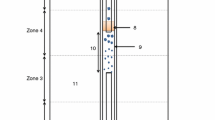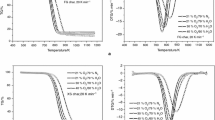Abstract
Coal and char oxycombustion is a complex process because of very high reaction rate of oxygen with coals and chars carbon. Very important process during oxycombustion is diffusion of O2 to surface of coal and char grain. This process can be minimized using small samples and high flow of the gas, but it is also dependent on temperature. For this reason, it is impossible to eliminate diffusion processes which cause significant impact on calculated kinetic parameters. This paper describes the results of thermogravimetric studies of oxycombustion process with evolved gas analysis by FTIR. Ultimate and proximate analysis of coal and char were made. Thermogravimetric experiments of coal and its char oxycombustion were conducted using five heating rates, namely 2.5, 5, 10, 20 and 40 K min−1, and gas mixture composed of 20 % O2 in CO2. Activation energies of coal and char oxycombustion were calculated by isoconversional methods: integral Vyazovkin and differential Friedman. Activation energies for three ranges of heating rates were calculated. This paper shows influence of heating rate on calculated activation energy. The reason of this phenomenon is due to change of the mechanism of coal and char oxycombustion from the chemical kinetic control regime to mixed chemical kinetic–diffusion control regime.







Similar content being viewed by others
Abbreviations
- A :
-
Pre-exponential factor (s−1)
- AC:
-
Ash content (wt%)
- β :
-
Heating rate (K min−1)
- E :
-
Activation energy (kJ mol−1)
- m :
-
Mass (mg)
- n :
-
Number of experiments
- M :
-
Moisture content (wt%)
- R :
-
Universal gas constant (kJ mol−1 K−1)
- T :
-
Absolute temperature (K)
- t :
-
Time (s)
- V :
-
Volatile matter content (wt%)
- X :
-
Fractional conversion degree of solid (−)
- ash:
-
Mineral matter
- D:
-
Diffusion
- R:
-
Reaction
- X :
-
Fractional conversion degree of solid (−)
- t :
-
Total
- 0:
-
Initial state
- ad:
-
Air-dried basis
- d:
-
Dry basis
- daf:
-
Dry and ash-free basis
References
Wall T, Liu Y, Spero C, Elliot L, Khare S, Rathnam R, Zeenathal F, Moghtaderi B, Buhre B, Sheng C, Gupta R, Yamada T, Makino K, Yu J. An overview on oxyfuel coal combustion—state of the art research and technology development. Chem Eng Res Des. 2009;87:1003–16.
Buhre BJP, Elliott LK, Sheng CD, Gupta RP, Wall TF. Oxy-fuel combustion technology for coal-fired power generation. Prog Energy Combust Sci. 2005;31(4):283–307.
Murphy JJ, Shaddix CR. Combustion kinetics of coal chars in oxygen-enriched environments. Combust Flame. 2006;144:710–29.
Hu Y, Naito S, Kobayashi N, Hasatani M. CO2, NOx and SO2 emissions from the combustion of coal with high oxygen concentration gases. Fuel. 2000;79(15):1925–32.
Haakvort G, Schouten J, Valkenburg PJ. The determination of coal combustion kinetics with thermogravimetry. J Therm Anal Calorim. 1989;35:335–46.
Gil MV, Riaza J, Álvarez L, Pevida C, Pis JJ, Rubiera F. Oxy-fuel combustion kinetics and morphology of coal chars obtained in N2 and CO2 atmospheres in an entrained flow reactor. Appl Energy. 2012;91:67–74.
Selcuk N, Yuzbasi NS. Combustion behaviour of Turkish lignite in O2/N2 and O2/CO2 mixtures by using TGA–FTIR. J Anal Appl Pyrol. 2011;90:133–9.
Yuzbasi NS, Selcuk N. Air and oxy-fuel combustion characteristics of biomass/lignite blends in TGA–FTIR. Fuel Process Technol. 2011;92:1101–8.
Niu S, Han K, Lu C. Characteristic of coal combustion in oxygen/carbon dioxide atmosphere and nitric oxide release during this process. Energy Convers Manag. 2011;52:532–7.
Fei H, Hu S, Xiang J, Sun L, Fu P, Chen G. Study on coal chars combustion under O2/CO2 atmosphere with fractal random pore model. Fuel. 2011;90:441–8.
Everson RC, Hein W, Neomagus JP, Kaitano R. The random pore model with intraparticle diffusion for the description of combustion of char particles derived from mineral- and inertinite rich coal. Fuel. 2011;90:2347–52.
Bhatia SK, Perlmutter DD. A random pore model for fluid–solid reactions: I. Isothermal, kinetic control. AIChE J. 1980;72:379–86.
Łabojko G, Kotyczka-Morańska M, Plis A, Ściążko M. Kinetic study of polish hard coal and its char gasification using carbon dioxide. Thermochim Acta. 2012;549:158–65.
Liu H. Combustion of coal chars in O2/CO2 and O2/N2 mixtures: a comparative study with non-isothermal thermogravimetric analyzer (TGA) tests. Energy Fuels. 2009;23:4278–85.
Niu SL, Lu CM, Han KH, Zhao JL. Thermogravimetric analysis of combustion characteristics and kinetic parameters of pulverized coals in oxy-fuel atmosphere. J Therm Anal Calorim. 2009;98:267–74.
Otero M, Gómez X, García AI, Morán A. Non-isothermal thermogravimetric analysis of the combustion of two different carbonaceous materials coal and sewage sludge. J Therm Anal Calorim. 2008;93:619–26.
Sarwar A, Khan MN, Azhar KF. Kinetic studies of pyrolysis and combustion of Thar coal by thermogravimetry and chemometric data analysis. J Therm Anal Calorim. 2012;109(1):97–103.
Dickinson CF, Heal GR. A review of the ICTAC kinetics project, 2000. Part 2. Non-isothermal results. Thermochim Acta. 2009;494:15–25.
Niu S, Han K, Zhou F, Lu C. Thermogravimetric analysis of the decomposition characteristics of two kinds of calcium based organic compounds. Powder Technol. 2011;209:46–52.
Niu S, Han K, Lu C, Sun R. Thermogravimetric analysis of the relationship among calcium magnesium acetate, calcium acetate and magnesium acetate. Appl Energy. 2010;87:237–2242.
Vyazovkin S. Advanced isoconversional method. J Therm Anal Calorim. 1997;49:1493–9.
Vyazovkin S, Burnham AK, Criado JM, Pérez-Maqueda LA, Popescu C, Sbirrazzuoli N. ICTAC Kinetics Committee recommendations for performing kinetic computations on thermal analysis data. Thermochim Acta. 2011;520:1–19.
Hurt RH, Calo JM. Semi-global intrinsic kinetics for char combustion. Combust Flame. 2001;125:1138–49.
Hu YQ, Nikzat H, Nawata M, Kobayashi N, Hasatami M. The characteristics of coal–char oxidation under high partial pressure of oxygen. Fuel. 2001;80:2111–6.
Acknowledgements
The results presented herein were obtained from research work co-financed by the National Centre of Research and Development in the framework of Contract SP/E/2/6642/10 ‘Advanced Technologies for Energy Generation: Oxy-combustion technology for PC and FBC boilers with CO2 capture’.
Author information
Authors and Affiliations
Corresponding author
Rights and permissions
About this article
Cite this article
Babiński, P., Łabojko, G., Kotyczka-Morańska, M. et al. Kinetics of coal and char oxycombustion studied by TG–FTIR. J Therm Anal Calorim 113, 371–378 (2013). https://doi.org/10.1007/s10973-013-3002-x
Received:
Accepted:
Published:
Issue Date:
DOI: https://doi.org/10.1007/s10973-013-3002-x




